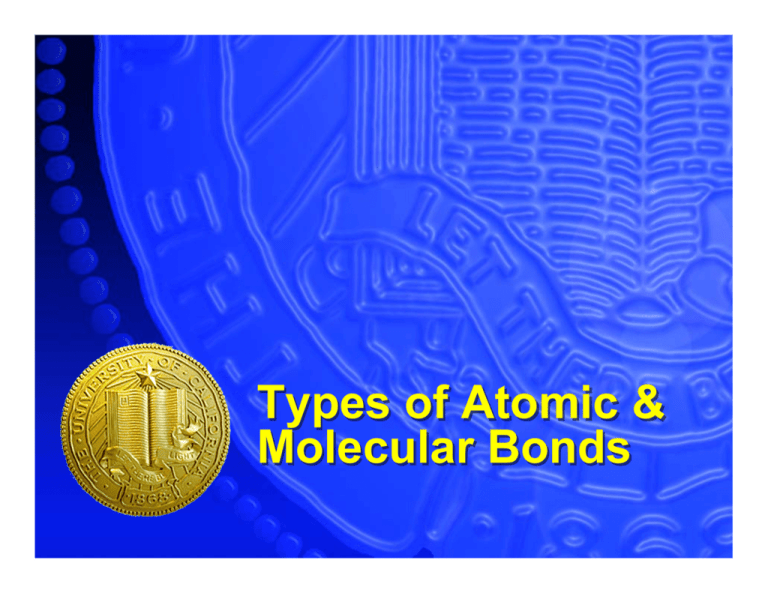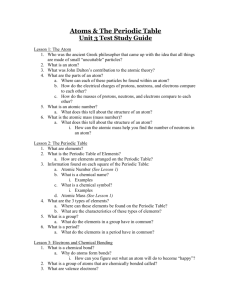Types of Atomic & Molecular Bonds
advertisement

Types of Atomic & Molecular Bonds Types of Atomic & Molecular Bonds Objectives of the class Develop a sense of history of scientific thinking Explain the types of bonds You should be able to have develop simple models for the mechanical properties based on the type of bond Long Tradition in Science Greek philosopher Leucippus used the word atom, which means indivisible (400 BC) Lots of work done by the alchemists Lavoisier: chemical reaction leads to no net loss or gain of matter. Dalton: concept of atomic mass (1808) Mendelev: periodic table of elements (1869) Moseley: showed that the number of electrons = number of protons (atomic number) Discovery of X-rays Wilhelm Conrad Roentgen first Nobel prize in physics (1901) Long Tradition in Science (cont.) Ruterford: experiments with alpha particle (1907-11) Max Planck: quanta (1900) Louis de Broglie: all matter has both wave and particle properties (1923). Types of Atomic & Molecular Bonds Primary Atomic Bonds IMPORTANT!!! Ionic Bonds Covalent Bonds Metallic Bonds Secondary Atomic & Molecular Bonds Permanent Dipole Bonds Fluctuating Dipole Bonds Ionic Bonding Large interatomic forces are created by the “coulombic” effect produced by positively and negatively charged ions. Ionic bonds are “nondirectional”. The “cation” has a + charge & the “anion” has the - charge. The cation is much smaller than the 17 anion. 11 Historical Note Greek philosopher Empedocles (500 BC) suggested that chemical changes are caused by an emotional likes and dislikes. The love between two substances will make them unite and form a third substance. On the other hand, if the substances start to hate each other they will decompose. Force vs. Separation Distance 2 Fatra Frep Z1 Z 2 e =− 2 4πε a nb = − n +1 a Simple example Calculate the coulombic force of attraction between Na+ and Cl- in NaCl. Note rNa + = 0.098nm rCl− = 0.181nm Energy vs. Separation Distance example Modulus of Elasticity Effect of temperature Ionic Bonding in Solids Because the ionic bond is nondirectional the ions pack together in a solid in ways which are governed by their relative sizes. Another important factor is that the ions must be arranged so that their is local charge neutrality. [Note the structure of NaCl.]. Covalent Bonding Large interatomic forces are created by the sharing of electrons to form directional bonds. The atoms have small differences in electronegativity & close to each other in the periodic table. The atoms share their outer s and p electrons so that each atom attains the noble-gas electron configuration. Representations discrete cloud Covalent Bonding in Carbon A carbon atom can form form sp3 orbitals directed symmetrically toward the corners of a tetrahedron. [Note the examples below.] Diamond Metallic Bonding Large interatomic forces are created by the sharing of electrons in a delocalized manner to form strong nondirectional bonding. Metalic Bond It is convenient for many purposes to regard an atom in a metal as having a definite size, which may be defined by the distance between its center and that of its neighbor. This distance is that at which the various forces acting on the atom are in equilibrium. In a metal, the forces can be considered as – (a) the attractive forces between electrons & positive ions, – (b) the repulsion between the complete electron shells of the positive ions, & – (c) the repulsion between the positive ions as a result of their similar positive charges. The Hard Sphere Model This approach can be called the "hard sphere" model of an atom. The radius of an atom (or ion) determined for a particular crystal structure is not a real characteristic of that atom, because when the same atom appears in different crystal structure it displays different radii. The radius of an atom (or ion) can be determined for a particular metal by using the dimensions of the unit cell of the crystal structure it forms. Secondary Atomic & Molecular Bonds [Van der Waals Bonds] Permanent Dipole Bonds – Weak intermolecular bonds are formed between molecules which possess permanent dipoles. – A dipole exists in a molecule if there is asymmetry in its electron density distribution. Fluctuating Dipole Bonds – Weak electric dipole bonding can take place among atoms due to an instantaneous asymmetrical distribution of electron densities around their nuclei. – This type of bonding is termed fluctuation since the electron density is continuously changing. Polar dipole Van der Walls bonds Question If ionic forces are so strong, how come does salt (NaCl) dissolves so quickly in water??? Water has a very interesting structure Why ice floats in liquid water?





